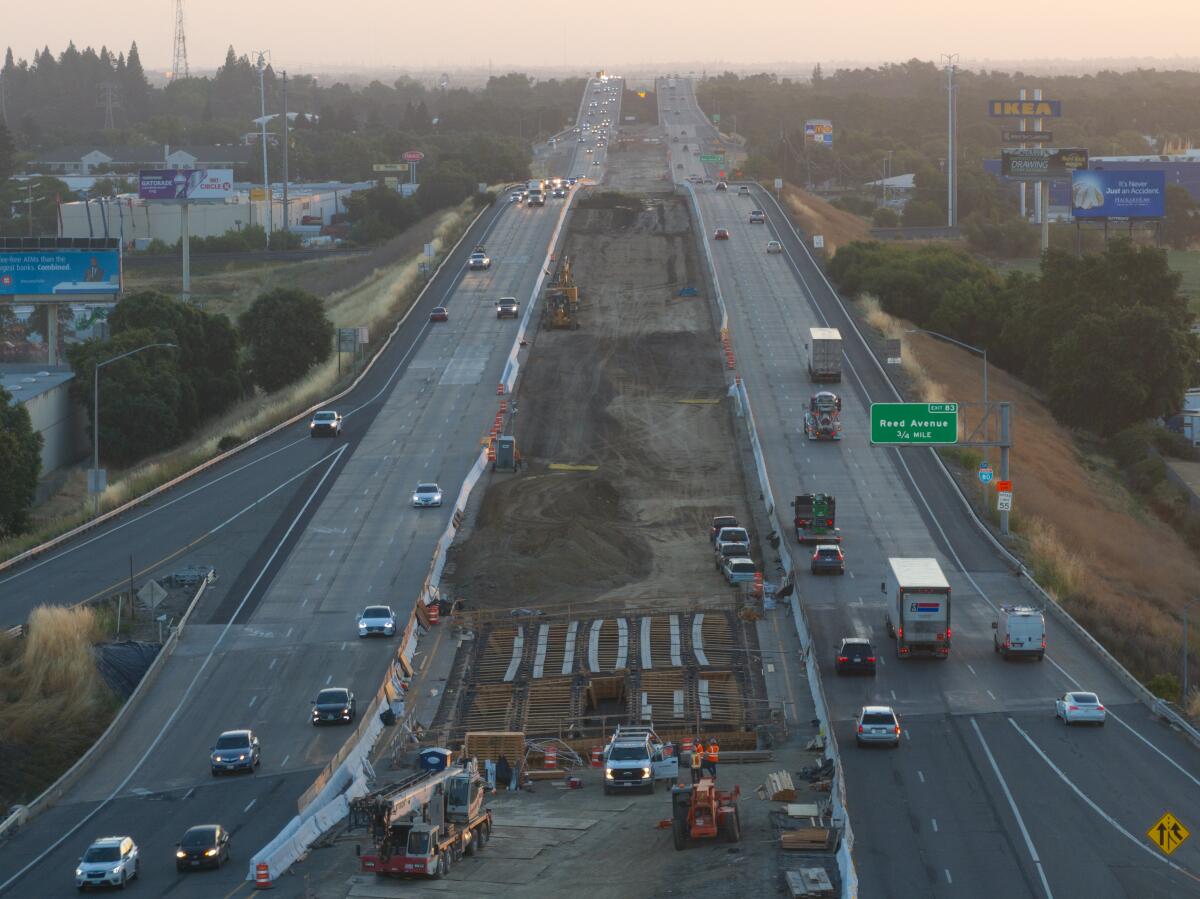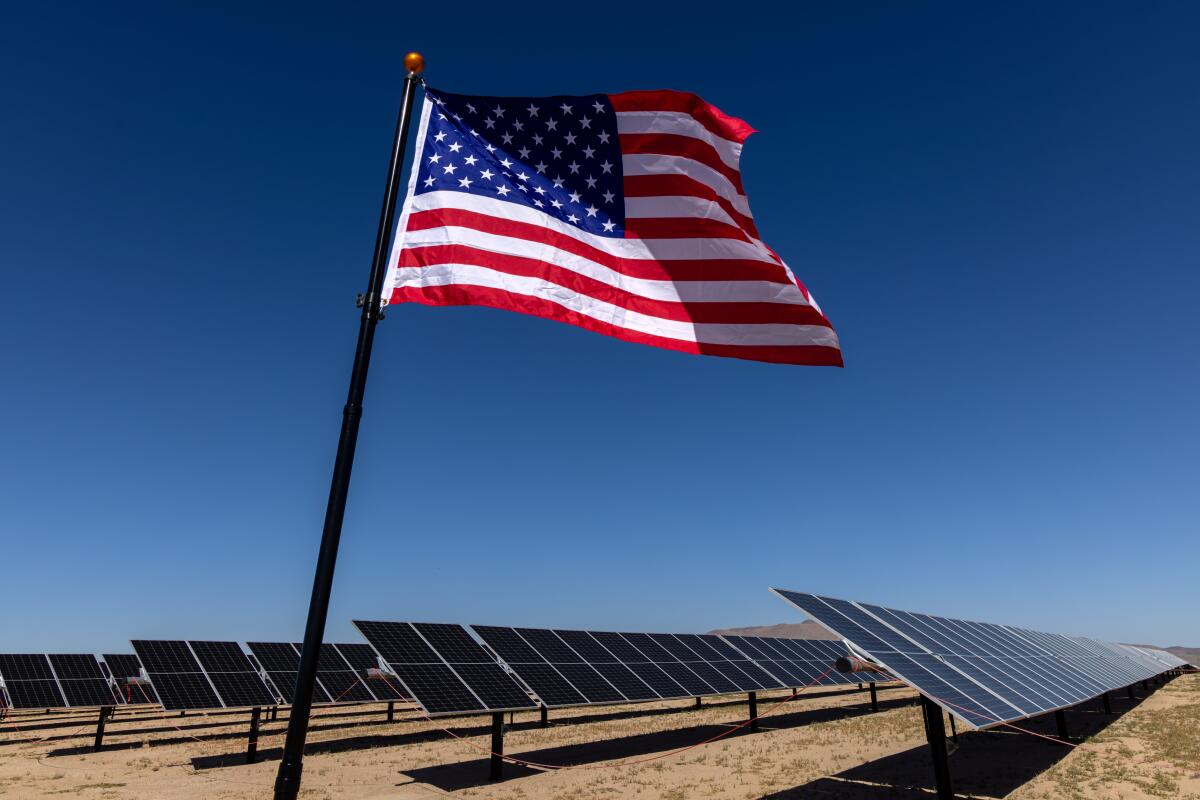Boiling Point: Sitting in traffic sucks. Climate change is worse

- Share via
The more time I spend writing about climate change — and air pollution, and freeways, and heat, and nuclear power, and lithium-ion batteries — the more I think human beings, myself included, can be pretty terrible at evaluating risk and reward.
First and most frustrating example: Our unquenchable thirst for driving, dangers be damned.
More than 42,000 people were killed in motor vehicle crashes on U.S. roads in 2022, with an estimated 2.38 million injured. Those are eye-popping numbers even before accounting for the fact that transportation is the nation’s largest source of planet-warming pollution, generating nearly 30% of carbon emissions nationally and close to 40% in California. The heat waves, wildfires, floods and other weather extremes fueled by those heat-trapping emissions add to the overall harm.
You're reading Boiling Point
Sammy Roth gets you up to speed on climate change, energy and the environment. Sign up to get it in your inbox twice a week.
You may occasionally receive promotional content from the Los Angeles Times.
And yet, not only do we continue to burn gasoline — we continue to expand freeways, even in climate-conscious California.
My L.A. Times colleague Rachel Uranga explored that conundrum in this insightful story about a nearly half-billion-dollar effort by Gov. Gavin Newsom’s administration to widen Interstate 80 between Sacramento and Davis. The goal is to reduce congestion on a clogged stretch of highway, which sounds good — nobody likes traffic. But in the long run, transportation experts warn, widening freeways typically induces more driving, ultimately causing traffic to back up again — and making global warming worse.
Why are we doing this to ourselves? Why are we so bad at weighing risk and reward?
A few more examples — all of them, I’m sorry to say, dealing with Newsom and his appointees:
- California will finally have extreme heat protections for people who work indoors — five years delayed, and not for people who work in prisons, because Newsom’s finance officials decided that would be too expensive. These shortcomings despite the fact that heat is a vicious killer. (Stories by Suhauna Hussain, L.A. Times, and Seth Borenstein, Associated Press)
- Officials have recommended California’s first indoor cooling standards for homes. But they would apply only to new homes, meaning landlords wouldn’t be required to install air conditioners in existing apartments. (L.A. Times editorial board)
- Solar installers are suing state officials, arguing the Newsom administration illegally bent to the will of electricians’ unions by blocking them from adding batteries to home solar systems. (Sam Ribakoff and Sergio Frez, Courthouse News Service)
For background on that one — the battle between solar installers and electricians’ unions — see this story I wrote in 2021.
But the common thread is this: Instead of putting carbon at the center of his decision-making — which is what one of the world’s most powerful politicians should be doing just about every time — Newsom is treating climate like most other political issues.
Some days he and his team are taking groundbreaking steps to phase out gasoline cars; other days they’re expanding freeways, and failing to fully protect people from extreme heat because they’re worried it would be too expensive, and making it harder to install batteries. They’re letting politics play far too large a role in the risk-reward calculation, to all of our detriment.

To be fair, it’s not just Newsom exercising faulty judgment.
I’m sympathetic to rural and suburban communities worried about renewable energy projects changing the look and feel of their neighborhoods, and potentially posing health and safety hazards. But we need to have discussions grounded in reality — a reality in which global warming poses serious threats to everyone. Threats that we need renewable energy to resolve, fast.
To wit: It’s not great that it took two weeks to put out a recent lithium-ion battery fire in San Diego County. It’s also not great that the fire has stirred up opposition to other battery projects, as the San Diego Union-Tribune’s Rob Nikolewski reports.
If a developer wanted to build a battery next door to my apartment building, I’m sure I’d do my due diligence.
But hopefully I’d learn that fires are relatively rare, and that we need huge amounts of energy storage to bank solar electricity for after dark and ditch fossil fuels, which are making the planet far more dangerous for myself and future generations. Hopefully I’d remember that I’m way more likely to die the next time I get in my car and hop on the 405 than I am in a battery blaze.
Risk. Reward. The principles make sense in your head; the trick is putting them into practice.
Sometimes, putting them into practice means spending money, even when there’s a large budget deficit. California officials have just estimated, for instance, that supplying clean drinking water to all Californians will cost more than $11.5 billion, as The Times’ Ian James reports. That sounds like a lot, but what other choice do we have? Everyone deserves clean water.
Another example: Increasingly extreme weather, aging infrastructure and growing use are causing certain mountain highways to crumble. Wyoming’s precarious Teton Pass is only the latest instance, Christine Peterson reports for High Country News.
The crux of the problem, as one expert told Peterson: “We don’t spend money until the bad thing happens.”
We need to start paying the toll before bad things happen. It’s less expensive — and less deadly, too.
We also need to be willing to question our long-held ideas and assumptions.

Take nuclear power: Although I’ll admit that I’ve never reported extensively on nuclear safety — and there are clearly continued environmental and health issues with nuclear waste disposal — it’s striking to me that shutting down nuclear plants continues to be so important to many (but not all) environmentalists. This despite the fact that serious nuclear plant incidents have been few and far between — and despite the fact that nuclear reactors supply nearly one-fifth of U.S. electricity, free of carbon.
To me, that’s a risk-reward problem. It’s easy to magnify the risks and minimize the rewards.
Hopefully, evaluating some of these trade-offs gets easier over time.
On the nuclear front, the Sacramento Bee’s Ari Plachta reports that Newsom has persuaded legislative leaders to put up another $400 million to help Pacific Gas & Electric keep the Diablo Canyon nuclear plant running beyond 2025. Whether that’s a good deal, I’m not sure. But the longer Diablo Canyon is around, the easier it will be for California to reach 100% climate-friendly energy.
At the federal level, President Biden is expected to sign a bill — approved by large bipartisan majorities in Congress — that would make it easier for companies to build advanced nuclear reactors. Details here from HuffPost’s Alexander C. Kaufman.
And as for those traffic-choked freeways?
Hopefully over time, as we get more electric cars on the road, “induced demand” from highway expansions will become less of a problem, because more of the cars sitting in traffic will be powered by solar and wind. But for now, state officials have made very clear — in theory, not in practice — that electrification isn’t enough. We also need to start driving less. California’s formal climate plan sets targets of reducing “vehicle miles traveled” by 25% per person by 2030, and 30% by 2045.
That means we’ll need to spend more time walking, biking and taking trains and other public transit — and more money building infrastructure to support those modes of transit. So why is Newsom wasting nearly half a billion dollars widening a freeway when the result will be more smog-spewing traffic, more climate pollution and less money for the stuff we actually need?
Because, sadly, he’s a human being. Like the rest of us, he’s got the risks and the rewards all screwed up.
Let’s demand better.
I’ll be assisting in The Times’ coverage of tonight’s debate between President Biden and former President Trump, so stay tuned for that. (Go to latimes.com or follow me on X.) Hopefully they talk about the climate crisis, or I won’t have much to do.
Here’s what else I’m following:
AROUND THE WEST

California is burning. Although it’s too early to say exactly how bad this fire season will be — check back a few months down the road — things have been intense recently. My L.A. Times colleague Grace Toohey made a chart showing that through June 19, three times as many acres had burned in California compared with the same time period in the worst of the previous five years.
In related news, global fossil fuel consumption hit a record high in 2023, per the Guardian’s Jillian Ambrose.
If you want to protect yourself or a loved one from wildfire smoke — especially important for people with sensitive lungs — The Times’ Karen Garcia has valuable advice. And as for what to expect later this summer and fall? “We could in fact see a very active finish to fire season 2024, but we aren’t there yet,” climate scientist Daniel Swain told my colleague Hayley Smith.
Going back to risk and reward, we should remember that taking proactive steps — even ones that cost money — to limit wildfire risks can offer other rewards. The Arizona Republic’s Hayleigh Evans, for example, reports on a new study quantifying the benefits of forest thinning not only for reducing fire danger, but also for increasing downstream water supplies.
Which brings us to this week’s jet stream of water news — much of it reported by The Times’ Ian James.
Continuing with risk/reward, Ian wrote about a new study from UC Berkeley scientists finding that even in water-scarce California, only 8% of rivers and streams have gauges that measure the flow of water — despite our pressing need to know how much water we’ve got and where it’s going, in order to make smart decisions. Clearly, we need to spend some money on more gauges.
Ian also wrote about a third attempt by state lawmakers to pass a bill that would stop farms from sucking up so much water that canals buckle and drinking water wells run dry. For the third time, the bill failed — despite support from Gov. Gavin Newsom.
There are so many water battles flaring across California, it can be hard to keep track. A few more:
- White sturgeons are bigger than mountain lions — and California may protect them under the state Endangered Species Act. Many water districts serving cities and farms are opposed, worried about restrictions on pumping. (Ian James, L.A. Times)
- Environmental groups aren’t giving up their courtroom fight to block Sites Reservoir, even after a judge’s initial ruling that was celebrated by Newsom, who supports the Northern California water storage project. (Ari Plachta, Sacramento Bee)
- There’s a San Diego angle to the recent sidelining of the Metropolitan Water District of Southern California’s general manager — although this time San Diego wasn’t fighting with L.A., or even the Imperial Valley. (Scott Lewis, Voice of San Diego)

The Supreme Court is taking an interest in Western water, too. In a 5-4 decision, the justices rejected a three-state settlement on the Rio Grande River — a ruling that could affect Colorado River negotiations, potentially giving the federal government a stronger hand, per Jennifer Yachnin at E&E News. The justices will also consider overturning a lower-court decision blocking a controversial oil train that would allow waxy Utah crude to be transported along the Colorado River, as Tom Hesse reports for CPR News.
In this week’s most uplifting water news, the demolition of several Klamath River dams has allowed California to return thousand of acres of land that were previously underwater to the Shasta Indian Nation. “Now we can return home, return to culture, return to ceremony, and begin to weave a new story,” the tribe’s chair, Janice Crowe, told my L.A. Times colleague Tyrone Beason.
Meanwhile, the federal government has acknowledged for the first time its historic role in devastating the lives and livelihoods of Pacific Northwest tribes by damming the Columbia River watershed. Details here from the Associated Press’ Gene Johnson.
Elsewhere in the Pacific Northwest, Johnson writes that a federal judge has ordered BNSF Railway to pay the Swinomish Tribe nearly $400 million for illegally running trains carrying crude oil across the tribe’s Washington reservation for nearly a decade.
A couple more classic Western tales:
- This Mojave Desert yarn has it all: a seven-story rock, rumors of aliens, gentrification, Howard Hughes, conservation concerns and a mysterious prophecy. Also check out this timeline of Giant Rock’s recent history. (Alex Wigglesworth, L.A. Times)
- “Here, embracing nature’s limits makes the inevitability of death feel strangely expansive, like it connects us to other species and other ecosystems.” A thoughtful story on an L.A. artist tackling climate anxiety. (Catherine G. Wagley, L.A. Times)
POLITICAL CLIMATE

Ahead of Thursday’s presidential debate, my usual reminder: As much as President Biden leaves to be desired on climate, there’s no question he’d give human civilization much better chances of a safe, healthy future than his opponent.
Exhibit A: The Inflation Reduction Act. CNN’s Ella Nilsen and Renée Rigdon report that companies have announced $346 billion in clean energy investments since Biden signed the landmark climate legislation two years ago, with almost four-fifths of the money pouring into Republican congressional districts — a reality that seems to be blunting GOP zeal for repealing the law.
It’s an encouraging sign that reality still matters, at least sometimes.
I was similarly encouraged reading this story by Jake Bolster, for Inside Climate News, about a conservationist and an economic development official trying to help a Wyoming coal town embrace solar development before coal revenues dry up — with some success, by the sounds of it. Maybe there are places we can set politics aside and accept that the world is changing.
I was less encouraged reading this story by the Casper Star-Tribune’s Zakary Sonntag, about another Wyoming coal town, where some residents aren’t happy to see Microsoft co-founder Bill Gates funding a next-generation nuclear plant that could rescue the local economy — in part because they don’t like Gates’ liberal politics. Maybe modern politics are inherently toxic.
Or maybe we need to work harder to build bridges despite our differences, as I’ve argued previously.
Protecting the greater sage grouse could be a good starting point.
Thus far, federal officials have kept the iconic Western bird off the endangered species list, despite a history of widespread cattle grazing and oil and gas drilling on public lands. But protecting the sage grouse isn’t getting easier, especially with solar and wind energy development now added to the equation. Here’s the latest state of play from Inside Climate News’ Wyatt Myskow.
California officials are trying to strike their own delicate balancing act, as renewable energy and conservation increasingly come into conflict. The Times’ Noah Haggerty has a thoughtful look at the state’s still-evolving plan to protect Joshua trees by studying their genetics and potentially relocating some trees, as temperatures rise, wildfires get worse and more solar farms are built.
A few more stories in this vein:
- Researchers in New Mexico are tracking how solar development is affecting pronghorn migration. There’s a lot we don’t know yet. “What do we tell the solar company to do to mitigate impacts?” one biologist asked. (Sarah Tory, High Country News)
- As a federal agency considered whether to approve a big energy storage project in Washington state, the Yakama Nation declined to share confidential ceremonial and cultural knowledge with the agency, worried it would end up becoming public. Now the agency is poised to approve the project anyway, without consulting the tribe. (B. ‘Toastie’ Oaster, High Country News)

While many of us try to work out the hiccups in the energy transition, others continue to peddle fossil fuels.
Utah Gov. Spencer Cox, for instance, is trying to save the coal-fired Intermountain Power Plant, which supplies electricity to Los Angeles and is slated to close next year — and which L.A. is happy to be rid of. It sounds like Cox is banking on Trump winning reelection and making the job easier, based on this story by the Salt Lake Tribune’s Bryan Schott and Tim Fitzpatrick.
Fortunately, some elected officials are trying to hold the fossil fuel industry accountable.
That includes the Colorado city of Boulder, which — following a favorable decision by a district court judge — will be able to take oil companies ExxonMobil and Suncor Energy to trial for their role in fueling the climate crisis, per Sam Brasch at CPR News.
It also includes lawmakers in California and several other states who have proposed bills that would require gas stoves to come with warning labels highlighting respiratory health risks, particularly for children. Details here from Politico’s Wes Venteicher.
And as for California Gov. Gavin Newsom?
As two of California’s largest oil drillers prepare to merge, a new state law should require them to put up the money to plug low-producing wells down the road so that heat-trapping emissions and toxic gases don’t leak out. But when Capital & Main’s Aaron Cantú asked state officials whether the companies would be required to comply, those officials didn’t have much to say.
A few other political tidbits:
- The Whittier City Council voted to remove 80 ficus trees as part of an uptown redevelopment project. (Lila Seidman, L.A. Times)
- The Biden administration will limit logging in old-growth forests. ( Matthew Brown, Associated Press)
- Californians will still be able to get free passes to state parks at public libraries, thanks a budget deal struck by Newsom and legislative leaders. The free passes are especially important for low-income families of color. (Jireh Deng, L.A. Times)
L.A. INFLUENTIAL

The Los Angeles Times — great news organization to which you should really be paying for, by the way — has been publishing a fascinating series of short profiles of the most influential people in Los Angeles. It’s called L.A. Influential. Check it out.
Here are some of the climate- and environment-relevant profiles that have stood out to me so far, in alphabetical order...
- Adel Hagekhalil: Will the embattled Metropolitan Water District general manager continue as Southern California’s “water doctor,” trying to shift the region from imported to local supplies? Or is his time coming to an end? (Profile by Ian James)
- Mia Lehrer: Her landscape architecture firm works at the nexus of sustainability and design, with a focus on climate, equity and the Los Angeles River. She also serves on the board of the L.A. Department of Water and Power. (Carolina A. Miranda)
- Manuel Pastor: “When people ask me why I love Los Angeles, I always answer it’s because it’s got the world’s biggest problems.” This USC activist scholar has put climate equity front and center in his research. (Gustavo Arellano)
- Lynda and Stewart Resnick: These billionaire agriculture barons and philanthropists have huge influence over California’s water supplies, sustainability research and grocery store produce aisles. It’s a Wonderful Co. life. (Laurence Darmiento)
- Marta Segura: Los Angeles is one of just a few U.S. cities with a chief heat officer. She’s doing everything she can to protect society’s most vulnerable, but her office has just six employees and an annual budget of $1 million. (Corinne Purtill)
- Gene Siroka: As executive director of the Port of Los Angeles, he’s trying to clean up California’s single largest source of air pollution while also attracting more business to a giant economic engine. It’s a tough job. (Ronald D. White)
A FEW MORE THINGS

We’re taking a break from Boiling Point next week for the July 4 holiday, so let me squeeze in a few final stories:
- Several carbon capture projects have broken ground in L.A. County, including one at a wastewater treatment facility that will also purify recycled water for drinking. Carbon capture is no panacea, but we will need some of it. (Hayley Smith, L.A. Times)
- Should we get lithium and cobalt for the energy transition from the depths of the oceans? Ahead of international negotiations on deep-sea mining in Jamaica, environmentalists are warning of possible harms to marine life. (Susanne Rust, L.A. Times)
- Southern California Gas Co.’s San-Diego-based parent company, Sempra Energy, has lined up another deep-pocketed customer for one of the fossil gas export terminals it’s developing on the Gulf Coast: Saudi Arabia. (Sourasis Bose, Reuters)
- About 30% of Americans think a lot about sustainability when deciding what to eat and drink. (Karen Kaplan, L.A. Times)
And because I love Disney: I enjoyed two recent columns by Robert Niles, editor of ThemeParkInsider.com. For one of them, Niles visited Disney’s new island retreat in the Bahamas, Lookout Cay at Lighthouse Point. Writing for the Orange County Register, Niles lauded the company for its conservation work, saying Disney must “continue protecting that space even as they promote it.”
He also opined on the company’s plans to expand Walt Disney World in Florida — and the challenge posed by the Orlando area’s increasingly brutal summer heat and humidity, which, he said, “these days too often feels incompatible with human life.”
“If Disney ever builds a fifth theme park in Florida, it needs to be all-indoors,” Niles wrote.
Climate change isn’t an environmental story. It’s an everything story.
ACTUALLY, ONE LAST THING

Speaking of Florida: Congrats to the Panthers on their first-ever Stanley Cup.
Now try not to go extinct?
I’m not talking about the National Hockey League team. I’m talking about actual Florida panthers.
Try this on for size: Back in 2015, the Natural Resources Defense Council and the Green Sports Alliance issued a report concluding that of the major North American professional sports teams with animal mascots, 31 of the 50 different species — more than 60% — were “at risk of going regionally or globally extinct in the wild.” And yes, the at-risk list included Florida panthers.
Like I said — climate change is an everything story. Mark Walter, are you listening?
This column is the latest edition of Boiling Point, an email newsletter about climate change and the environment in California and the American West. You can sign up for Boiling Point here. And for more climate and environment news, follow @Sammy_Roth on X.
Toward a more sustainable California
Get Boiling Point, our newsletter exploring climate change, energy and the environment, and become part of the conversation — and the solution.
You may occasionally receive promotional content from the Los Angeles Times.




